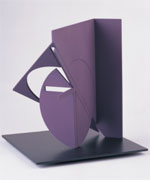I'm glad you decided to join me for five minutes in the virtual museum. Let's take a look at two sculptors, or artists who create sculptures, named Fletcher Benton and Richard Hunt. I am partial to both of these artists because Richard Hunt is a Chicago native and Fletcher Benton is currently exhibiting in my hometown of Omaha, Nebraska.
First, take a look at the following images for a few quiet minutes and then we'll discuss:
Folded Square Alphabet O Folded Square Alphabet U Folded Square Alphabet K
From the 2004 Series Alphabets II • by Fletcher Benton
Anvils Reach • 1989 • Richard Hunt
Sculptural Improvisation #2 • 1991 • Richard Hunt
----------------------------------------------------------------------------------------------
Choose one sculpture and consider these questions:
When you look at the sculpture, what is the first thing you notice?
What is the next thing you notice, why?
List the different lines, shapes, and colors that you see.
Does the sculpture remind you of anything?
What do you think the artist was thinking about when he was making this?
What would you name the artwork?
----------------------------------------------------------------------------------------------
First of all, the five examples are considered sculpture because:
* they are 3D, they have length, width, and depth.
* they are 3D, they have length, width, and depth.
* they exist in real space (when you see them in person) not space that is drawn or painted.
* they are made out of 3D shapes that are called "forms".
Some shapes are called geometric – squares, triangles, circles, or shapes that have a name.
Some shapes are called organic – shapes with soft or uneven edges, like those often found in nature.
Some shapes are called organic – shapes with soft or uneven edges, like those often found in nature.
Are most of these sculptures' shapes geometric or organic?
----------------------------------------------------------------------------------------------
These five sculptures are also considered Abstract. This is when the lines, shapes, colors, or textures are most important, rather than a recognizable object.
However, sometimes in Abstract Art you can recognize objects.
Are there any recognizable objects in any of the five sculptures?
----------------------------------------------------------------------------------------------
Click to download the PowerPoint for this lesson!
----------------------------------------------------------------------------------------------
These five sculptures are also considered Abstract. This is when the lines, shapes, colors, or textures are most important, rather than a recognizable object.
However, sometimes in Abstract Art you can recognize objects.
Are there any recognizable objects in any of the five sculptures?
----------------------------------------------------------------------------------------------
I hope you enjoyed this five minutes in the virtual museum. Check back later to see some of the artwork that can be made to go along with this visit!
Resources: Look at Art With Kids and Sculpture to Go





congrats! I have passed on a Versatile Blogger Award to you. Check out the rules here: http://kids-finelines.blogspot.com/
ReplyDelete:) Christie